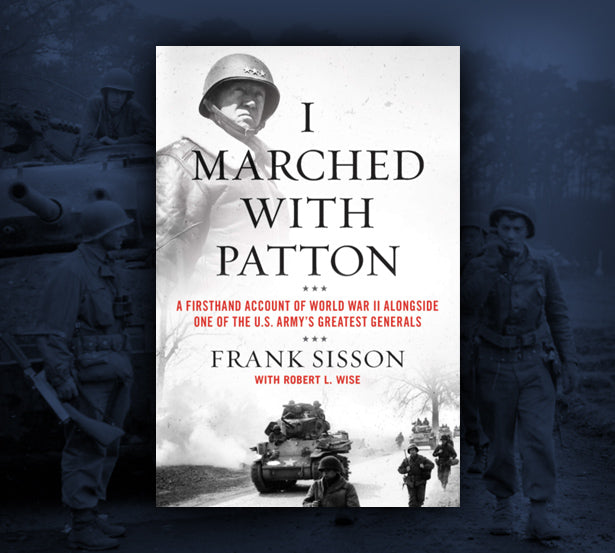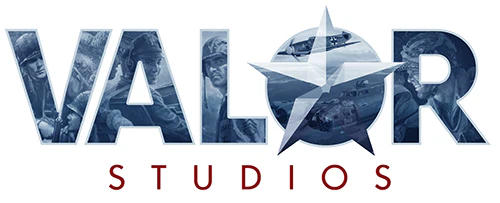-
LIMITED-EDITION: LESS THAN HALF REMAIN!
We have the hardback book I Marched With Patton available with a bookplate designed exclusively for Valor Studios that has been autographed by the book's author, WWII veteran Sgt. Frank Sisson, along with co-author Robert Wise. Enjoy the video below of Battle of the Bulge researcher Reg Jans sharing his favorite Sgt. Frank Sisson story.
Includes a COA // shipping added in checkout // ships bubble wrapped & boxed
-
A gripping firsthand account of World War II written by a soldier with the American Third Army who served under the legendary warrior and participated in many of the most consequential events of the conflict—including the Battle of the Bulge and the liberation of Dachau.
Following in the footsteps of the bestsellers All the Gallant Men, Every Man a Hero, Don't Give Up, Don't Give In, and Never Call Me a Hero, I Marched with Patton is a remarkable eyewitness account that offers priceless insights into a foot soldier’s life on the front lines during World War II under the command one of the legendary figures in American military history.
Now a spry ninety-five years old, Frank Sisson looks back at his life and his service in the Third Army. Born in rural Oklahoma, Frank grew up fatherless during the Great Depression. In 1944, at age eighteen, he enlisted and was deployed to France where he marched with Patton, taking part in many of the key Allied movements of the war. Frank fought in the Battle of the Bulge, nearly died crossing the Rhine with Patton, and was among the first American soldiers who liberated the notorious Dachau concentration camp.
After the war, Frank continued to serve in the army as a military police inspector in Berlin. When he finally returned home, he attended college and built a career in business.
Frank Sisson’s remarkable reminiscences provide a fresh, unique look at Patton’s leadership, the final year of World War II and its direct aftermath, and the experience of combat on the front lines.
I Marched with Patton includes 25 black-and-white photographs.
-
‘I Marched With Patton’ Review: From a Soldier’s Point of View
The fear and the sorrow of being a young, untried, unworldly American sent overseas to fight the Nazis during World War II.
By Mark Yost for the Wall Street Journal
Most of the new material about World War II in the past 30 years has come from two primary sources: the Russian and Eastern European archives opened since the fall of the Berlin Wall, and the personal diaries of veterans who had long remained silent but lately felt compelled to share what they had done and, more important, what they had seen during the biggest event of their lives. “I Marched With Patton,” the remembrances of Oklahoma native and Third Army Artilleryman Frank Sisson—transcribed and augmented by the writer Robert L. Wise —is clearly of the latter. Mr. Wise has done an able job of organizing Mr. Sisson’s account into a memoir that’s full of the good and bad of war—families torn apart, laughing comrades remembered —making this well worth the read.
You won’t learn anything new here about the broader strategies of the war. Mr. Sisson did not take part in the landing operations on D-Day. And he’s a little too fawning when it comes to Gen. Patton, with whom he had only passing encounters. Once, Cpl. Sisson was directing traffic at a busy crossroads in France when Patton’s jeep whizzed by. “General Patton looked me straight in the eye, smiling like he appreciated the way I was directing traffic. . . . I couldn’t believe my eyes. . . . General George Patton had grinned at me.”
Similarly, when Mr. Sisson recalls Patton’s strategy and boldness in saving the Allies during the Battle of the Bulge, you won’t find anything you didn’t already know from reading a Patton biography or watching the 1970 film.
What Mr. Sisson does provide is a firsthand account of the turmoil and destruction in France in December 1944 and later, on the road to Germany, as his unit marched into Berlin.
Mr. Sisson recalls having his eyes opened to the larger world for the first time while still in England awaiting deployment. It’s there that he meets Eli Cohen, a soldier from Philadelphia whose Jewish parents emigrated from Russia. Mr. Sisson admits to Cohen that he’s never met a Russian or a Jew, and that he’s never heard about any pogroms, including the one currently being conducted by the Nazis. “I stared at this man from Pennsylvania,” Mr. Sisson recalls. “No one had told me about such a horrible thing as killing people just because they were of another religion.”
When Mr. Sisson finally turns to his experiences during the war, he has an eloquence that belies the fact that he left school at 15 to support his family after the sudden death of his father. “Once the cannons started firing, the rumble was nonstop. We tried to plug our ears, but you couldn’t escape the detonation and the thunder. Constant bombardment drowned out even my innermost thoughts.”
But Mr. Sisson did have thoughts about the war and his role in it, even in an artillery unit firing at unseen enemies beyond the horizon. “You know every time one of those hundred-ten-pound shells go flying off,” he tells another soldier, “we might have killed who knows how many men?”
One of the most poignant passages in Mr. Sisson’s book comes when he meets an elderly couple in Érezée, Belgium. They offer to put him and his friend Randy Dobson up for the night. Together they drink wine, break bread. The soldiers ask about the couple’s family. “W-we had a s-son,” Mr. Sisson recalls the husband saying haltingly. “They lived across the street. . . . Three days ago the Nazis forced their way into my son’s house. They killed him, his wife, and the two children.” The couple “broke down sobbing,” Mr. Sisson recounts. “Dobson and I immediately got up and hugged them like they were our own family. We held them tight as they moaned and wept. We couldn’t help it; both of us began crying with them. For a long time, we held them. Eventually we all sat down at the table together. No one could speak.”
The next day Mr. Sisson and his unit are ordered to an area of Belgium where renewed fighting has broken out. “Is there a name for the target area?” Dobson asks. “Yeah,” the sergeant said. “Bastogne.” As they’re packing up to leave Érezée and the family that hosted them, Mr. Sisson “couldn’t help but stop and look directly across the street where their son and his family had once lived. No light shone through the dark windows. A wilted, frozen funeral wreath still hung on the door. For a few moments, I couldn’t look away.”
Mr. Sisson’s account also has lots of action. Often, he must expose himself to enemy fire while stringing communications wire high atop observation posts. He has several close scrapes, one coming soon after a German Messerschmitt is seen circling overhead. “Mortars began blasting in,” he recounts. “No reflection was needed to tell me that the Messerschmitt had reported us, and the enemy decided to blow me off the top of the rise. I made one last call on the line, telling the unit down there with the big guns that I was their new target and was signing off. I held my helmet on tight and dived into the nearest foxhole. I slapped my hands over my ears and hoped I wouldn’t go deaf. Huddled up in a prenatal ball, I started praying. Psalm 91 came immediately to mind.”
Mr. Sisson ultimately makes it through the war, finishing up with military-police duty in Berlin, where he meets a nice German girl who cooks him dinner, but no more than that. Although she obviously has affection for him, Mr. Sisson tells her that he has a girl waiting for him back in Oklahoma. Amid a homecoming worthy of Frank Capra, his mother asks him about the war. “I think General Sherman once said, ‘War is hell.’ Well, he was right. You really don’t want to know more than that. Just know that by God’s grace, I survived it.”
(And, yes, he got the girl. But not the one he expected.)









